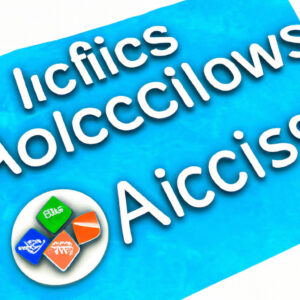How to Download and Utilize Access on Mac: An Engineer’s Perspective
As a software engineer and a mathematician, I was always fascinated by how algorithms could dance harmoniously with equations. Once, while studying Riemann Hypothesis, a landmark theorem in the realm of number theory, I stumbled upon an arresting synchrony between SQL queries and prime number sequences. This sparked my fascination with databases, leading me to work extensively with Microsoft Access.
Access may not be available natively for Mac, but fret not! There are multiple ways to bridge this gap. So, without further ado, let’s delve into understanding how to download Access on Mac.
Step 1: The Virtual Machine Approach
One of the best methods to use Access on a Mac is through a virtual machine (VM). Tools like Parallels Desktop or VMWare Fusion can create a Windows environment on your Mac where you can install and run Access smoothly.
Installing Parallels Desktop:
Download the .DMG file from the official site and follow the prompts. Once installed, you’ll have a fully functioning Windows environment within your Mac, ready to accommodate Microsoft Access.
Running Microsoft Access on Parallels Desktop:
– Install Windows OS in the Parallels desktop.
– Download MS Office from the Office website inside your Windows VM.
– Follow the instructions to install MS Access.
Similar steps apply to install Access using VMWare Fusion. It’s comparable to solving a complex mathematical problem: understanding the theory, applying the formula, and getting the desired result.
Step 2: The CrossOver Software Approach
If delving into the world of virtual machines seems daunting, here’s an alternate approach – CrossOver Mac. This software allows you to deploy Microsoft Access directly on Mac without needing a complete Windows environment.
Downloading and Installing CrossOver:
Go to the official CrossOver Mac website and download the latest version. It works just like any other Mac software installation.
Launching Microsoft Access on CrossOver:
– Open CrossOver and select ‘Install a Windows Application’.
– Enter ‘Microsoft Access’ into the search bar and select it.
– Click ‘Continue’ and follow the instructions to complete the installation.
Using MS Access: Similarities and Differences
With a successful installation, you can now explore Access on your Mac. You’ll realize that the functionalities remain quite similar to the Windows version. Table creation process, generating reports, and running SQL queries – everything follows the same pattern.
Yet, there might be some minor differences you need to familiarise yourself with. For instance, the keyboard shortcuts might vary slightly due to the different keyboard layout on Mac.
Final Thoughts: Relish the Power of Databases
Now that you know how to download Access on Mac, you can handle databases more efficiently and optimize your workflow. Remember that databases are to software engineers what prime numbers are to mathematicians – the building blocks!
While it might seem daunting at first, navigating these softwares works just like solving an equation – once you understand the underlying principles, it’s all smooth sailing.
Make sure to practice creating tables, writing sample queries, and creating relationships between tables. Just like in mathematics, practice is key in mastering databases.
Take your software engineering game a step higher with Access on your Mac as your new power tool. Enjoy exploring the fascinating world of databases, and may the code be with you!
Why You Should NEVER Use These Apps On Your Mac…
The FREE Microsoft Office Killer for MacOS | Hands-on with OnlyOffice
How To Download MS ACCESS 2019 In Windows 10
How do I install Access on my Macbook?
Unfortunately, you cannot directly install Microsoft Access on a Macbook as it’s not compatible. Microsoft doesn’t make a version of Access for macOS. However, there are several ways around this:
1. Install Windows on your Mac using Boot Camp:
Boot Camp allows you to choose between macOS and Windows each time you start your Mac. This solution requires a copy of Windows 10 which is not free.
– Open Boot Camp Assistant (located in Applications > Utilities).
– Follow the onscreen instructions to install Windows.
– Then you can purchase, download, and install Microsoft Access as you would on any other Windows machine.
2. Virtual Machine:
Use Parallels Desktop or VMware Fusion to run Windows inside your macOS, this way you don’t need to reboot your Mac. You still need a copy of Windows and these applications are not free either.
– Download and install Parallels Desktop or VMware Fusion.
– Follow the onscreen instructions to install Windows.
– Once Windows is installed, access the Windows Store to purchase and install Microsoft Access.
3. Remote Desktop:
If you have a PC that has Access installed, you can use a remote desktop application to access and use the software from your Mac.
Please note: These workarounds require a separate purchase of both Windows and Microsoft Access. If you’re looking for a free option, consider using a free alternative like LibreOffice Base or Google Sheets which can perform many of the same functions as Microsoft Access and are compatible with Macs.
Does Office 365 Access work on Mac?
Microsoft Office 365 offers a suite of productivity tools that are widely used in both professional and personal settings. However, it’s important to note, Microsoft Access, a part of this suite is not included in the Mac version of Office 365.
In other words, Microsoft Access does not work on Mac. It’s a database management tool designed specifically for Windows desktops. To use Microsoft Access on a Mac, you might consider using a virtual machine or dual-booting with a Windows partition. However, these aren’t perfect solutions as they’ll require significant amounts of storage and potentially advanced technical knowledge, not to mention a valid copy of Windows.
Instead, you can look for alternatives to Microsoft Access that are compatible with Mac, such as FileMaker Pro, LibreOffice Base, or Tap Forms.
Why doesn t Microsoft make Access for Mac?
Microsoft Access is a database management system from Microsoft that combines the relational Microsoft Jet Database Engine with a graphical user interface and software-development tools. It is part of the Microsoft Office suite of applications which includes Word, Excel, and PowerPoint.
Microsoft’s primary reason not to make Access available for Mac is mostly likely due to the fact that they want to differentiate their Windows operating system. By keeping certain popular software exclusive for Windows, it can serve as a unique selling point that attracts users to stick with or switch to this OS.
Additionally, developing a software requires investing in resources and time. Given that macOS has a comparatively smaller user base than Windows, Microsoft probably concluded that the investment on developing and maintaining a Mac version of Access would outweigh potential returns.
Furthermore, there may be some technical issues that make the development of Access for Mac difficult. Access relies heavily on ActiveX controls, which are not supported on Mac. Hence, porting Access to Mac would likely require a significant redesign of the software.
Finally, several alternatives to Microsoft Access are readily available on Mac, such as FileMaker Pro, SQLite, and Oracle. These options might decrease the demand for Access on Mac.
To conclude, while there’s no definitive answer since Microsoft hasn’t officially disclosed its reasons, the decision could be a combination of maintaining competitive advantage, resource allocation, technical complications, and presence of sufficient alternatives.
How do I download and install Access?
Downloading and installing Microsoft Access involves several key steps. Here they are, outlined for you:
1. Purchase Microsoft Office: Before you can download and install Access, you need to either purchase Microsoft Office or sign up for a subscription to Office 365. If you choose to purchase Office outright, make sure to select a version that includes Access.
2. Go to Office website: Visit the Microsoft Office website at www.office.com. In the upper-right corner of the screen, click on “Sign In” if you already have a Microsoft account. If not, create one.
3. Select Install Office: After logging in, find the “Install Office” option. This should be located on the home page of your Office account.
4. Start Download: Click on “Install Office” to start the download process. The Office installation package, including Access, will begin downloading to your computer.
5. Run Installation File: Once the download is complete, you need to run the installation file. Depending on your web browser, you might need to navigate to the downloads folder on your computer to find this file.
6. Follow Installation Steps: After running the installation file, follow the prompts on your screen to install Office onto your computer.
7. Launch Access: After installation is complete, you can launch Access by searching for it in your computer’s application list.
Remember, not all versions of Microsoft Office include Access so be sure to confirm before purchasing. Also, note that Access is only available on PC and is not supported on Mac.
“What are the steps to download Microsoft Access on a Mac?”
Microsoft Access is not included in the Office 365 package for Mac and there isn’t a version of Access specifically designed for MacOS. But don’t worry, there are ways to run Microsoft Access on your Mac:
1. Dual Boot Windows and MacOS: You can use Apple’s built-in Boot Camp software which allows you to install Windows alongside MacOS on your Mac. Here are the steps for this process:
a. Open Boot Camp Assistant (you can find it in the Utilities folder).
b. Follow the onscreen instructions which will guide you through the process of installing Windows on your Mac.
c. During the process, you will be asked to allocate storage to Windows. Remember that whatever storage you give to Windows will be taken away from MacOS.
d. Once installed, whenever you boot up your Mac, you will choose whether to continue into MacOS or switch to Windows.
2. Using a Virtual Machine: This method allows you to run Windows and MacOS at the same time, instead of having to reboot your computer. There are several software available like Parallels Desktop, VMware Fusion and VirtualBox.
a. Install any of these virtual machine software on your Mac.
b. Now install Windows within the virtual machine.
c. Finally, install Microsoft Access in the Windows environment.
3. Using a Remote Desktop: You can remotely connect to a PC that has Microsoft Access installed from your Mac.
a. Set up remote access on a PC with Microsoft Access installed.
b. Use a Remote Desktop client for Mac to remotely connect to the PC.
Remember, whichever method you choose, you’ll need a valid copy of Windows, and a Microsoft Access license or subscription.
“Is Microsoft Access compatible with MacOS and how can we download it?”
No, Microsoft Access is not natively compatible with MacOS. Microsoft has not developed a version of Access that works on MacOS. However, if you’re a Mac user and you need to use Access, there are a few alternatives that might work for you.
1. Virtualization Software: Programs like Parallels Desktop and VMware Fusion allow you to run Windows software on a Mac. You’ll need a copy of the Windows operating system and a copy of Access, but once you have those, you can install them on your Mac as if it were a Windows PC.
2. Boot Camp: Another option is to use Boot Camp, which is a utility included with your Mac that lets you switch between MacOS and Windows. Again, you’ll need a copy of Windows and Access, but this approach doesn’t require any additional software.
3. Remote Desktop: If you have access to a Windows PC elsewhere, you can use a Remote Desktop application to control that PC from your Mac. This would give you access to a full-fledged Windows environment, including Access.
4. Alternative Database Software: If you can’t or don’t want to use any of the above options, there are a number of alternative database programs that run on MacOS. These include FileMaker Pro, SQLite, and MySQL.
Remember that running Windows on a Mac, whether through virtualization or Boot Camp, requires a valid Windows license. It’s not a free solution, but it may be necessary if you need to use Access regularly.
“What alternatives can be downloaded for Microsoft Access on a Mac?”
There are several alternatives to Microsoft Access that can be used on a Mac. Some of these options include:
1. FileMaker Pro: This feature-rich software is a popular choice for both individuals and businesses. It includes a desktop application for Mac and it has a cloud-based web application that allows you to work from anywhere.
2. LibreOffice Base: LibreOffice Base is part of the LibreOffice suite, which is a free and open-source alternative to Microsoft Office. It provides a robust environment to develop data-driven applications with a wide range of built-in templates and wizards.
3. MySQL: MySQL is an open-source relational database management system that is compatible with all major platforms including MacOS. It offers superior performance, scalability, and reliability.
4. Apache OpenOffice Base: Apache OpenOffice Base is part of the Apache OpenOffice suite. It is another free and open-source alternative to Microsoft Office with many features similar to MS Access.
5. Ninox: Ninox is a cloud-based data collaboration and database software. Its clean, intuitive, and user-friendly interface makes it a top pick for Access alternatives on Mac.
Remember to consider individual needs in terms of ease of use, compatibility, cost, and specific features when choosing between these Microsoft Access alternatives for Mac.
“What should I consider before downloading Microsoft Access or its alternative on my Mac?”
Before downloading Microsoft Access or its alternative on your Mac, there are several key factors you need to consider:
1. Compatibility: Microsoft Access is designed to work on Windows system. Unfortunately, Microsoft does not support Access on Mac. Therefore, if you need to use Microsoft Access on your Mac, you will need a workaround such as setting up a Windows environment on your Mac through Boot Camp or a virtual machine software like Parallels Desktop.
2. Alternative Softwares: If you do not wish to go through the hassle of setting up a Windows environment on your Mac, you may want to consider alternatives to Microsoft Access. Open-source options such as LibreOffice Base and Apache OpenOffice Base are available and can meet many of the same needs as Microsoft Access.
3. Functionality: Before downloading an alternative software, consider what you will be using the database software for. Different kinds of software have varying degrees of functionality, so make sure the one you choose can perform the tasks you need it to.
4. Cost: Lastly, consider the cost of the software. Microsoft Access comes with a cost either as an individual purchase or as part of the Microsoft Office Suite subscription. Some alternatives may be free or may offer more cost-effective solutions.
5. Learning Curve: Each software will have its own learning curve. Ensure you have the time and resources to fully understand how to use the software efficiently.
In conclusion, before you download Microsoft Access or its alternative on your Mac, take into account these considerations to make an informed decision that best suits your needs.
“How can I troubleshoot issues faced while downloading Access on Mac?”
Troubleshooting issues with downloading Access on Mac can be a challenging task as, unfortunately, Microsoft Access is not compatible with Mac OS. Microsoft has not released a version of Access for macOS. However, there are several workarounds you can consider:
1. Virtualization: Run Windows operating system on your Mac using software like Parallels Desktop or VMware Fusion. Once you have Windows running on your Mac, you can then download and install Microsoft Access.
2. Boot Camp: This utility, provided by Mac, allows users to install and boot their device in Microsoft Windows. You could install Windows on a hard drive partition using Boot Camp, which would then allow you to install and use Microsoft Access.
3. Remote Desktop Applications: Another alternative is using applications like Microsoft Remote Desktop that allow users to mirror a PC with Microsoft Access installed onto their Mac.
4. Cross-platform database software: Consider utilizing cross-platform database software that functions similarly to Microsoft Access such as FileMaker Pro, Apache OpenOffice’s Base, or LibreOffice’s Base.
Remember, before using any of these solutions, ensure your Mac has the necessary hardware requirements and software updates. Always back up your data to prevent any potential loss.






